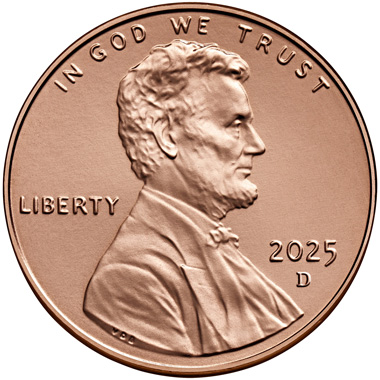 The U.S. penny was one of the first coins made by the U.S. Mint after its establishment in 1792. They were larger and made of pure copper compared to today’s one-cent coins, which are smaller and primarily zinc and about 2.5% copper.
The U.S. penny was one of the first coins made by the U.S. Mint after its establishment in 1792. They were larger and made of pure copper compared to today’s one-cent coins, which are smaller and primarily zinc and about 2.5% copper.
Making pennies today has become expensive: It costs 3.69 cents to make a one-cent coin and, according to the U.S. Mint, these unit costs have been above face value for 19 years.
Earlier this year, the U.S. Treasury Department announced that it will stop putting new pennies into circulation in early 2026. Eventually that will lead to pennies being far and few between for cash transactions, and retailers will have to round up or down to the nearest 5 cents. These rounding practices have been the norm in Canada since 2013, when the country stopped producing its one-cent coin.
Whether the U.S. Mint should continue to produce the one-cent coin is a nearly 50-year-old debate. There have been studies suggesting that less pennies in circulation could save time on transactions—including a joint NACS and Walgreens study from the 1980s that estimated retailers could save 2 to 2.5 seconds per transaction if they didn’t account for pennies.
“There are roughly 160 million transactions a day at U.S. convenience stores and about one-third are cash. If we remove two seconds from 52 million [cash] transactions a day, that equates to a little more than 1,000 days, or roughly three years. So if the penny were to go away, there could be time savings across c-stores that would be the equivalent of three years every single day,” said Jeff Lenard, NACS vice president of strategic communications, during the Convenience Matters podcast “How Eliminating the Penny in 2026 Affects Retailers.”
But what if a customer doesn’t pay with cash? Then a $2.07 transaction would be $2.07. However, if a customer pays with cash, that transaction would be rounded down to $2.05.
More Math—and Some Assumptions
Lenard explored the impact on coin usage if U.S. retailers stopped using pennies and had to handle transactions differently. He examined 100 permutations of change, along with a few assumptions:
- One assumption was to use the lowest number of coins possible. For example, for 30 cents change, a retailer would use a quarter and a nickel instead of three dimes.
- Out of the 100 different change possibilities, 20 of them remain unchanged. Transactions involving 5 cents, 10 cents, 15 cents, 20 cents, etc., would not be affected since they already use nickels, dimes, or quarters, with no pennies involved.
For 40 of the 100 transactions, the amount would be rounded down:
- If a customer spends 6 cents, they would pay 5 cents; if they spend 7 cents, they would pay 5 cents.
- Rounding down would not require more of any other coin, but it would remove 60 pennies from circulation when considering that the entire math of the 40 transactions that would be rounded down.
Next, he looks at the 40 transactions that would be rounded up:
- For example, an item costing $2.08 would be rounded up to $2.10.
- This would remove 140 additional pennies from circulation out of those 40 transactions
Looking at the 40 rounded-up transactions:
- There would be 16 more instances where a nickel would be used instead of penny change.
- 16 more instances where a dime would be used instead of penny change.
- 8 more instances where quarters would be used to round up.
- If a dime is used, it replaces a nickel.
- If a quarter is used to round up, it replaces two dimes.
After going through this entire process, the end result of 100 different transactions for change is that 200 pennies would be taken out of circulation—it would not add any nickels or dimes and it would all average out: 200 pennies removed equals 8 quarters added, said Lenard.
What Consumers Say About the Penny
In February, NACS surveyed consumers to find out their thoughts on whether the penny should stay or go. The survey found that 36% of consumers support getting rid of the penny, while 15% were in favor of keeping it. These numbers were from before the consumer was given any arguments in favor of removing the penny.
Next, when given reasons like the cost of producing pennies exceeding their value and potential time savings in transactions, support for eliminating the penny increased to 54%, suggesting that consumers understood why the issue became an issue.
More to come on the penny and how retailers can prepare. But until then, and in case you’re curious, the unit cost for nickels is 13.78 cents, which has also remained above face value for nearly two decades.